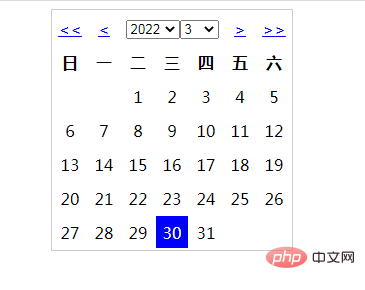浅析怎么使用PHP实现简单的日历程序?(附代码)
怎么使用PHP实现简单的日历程序?本篇文章就通过一个代码示例来大家了解一下使用PHP实现简单日历程序的方法,希望对大家有帮助。

说到对日期和时间的处理,就一定要介绍一下日历程序的编写,大多数读者可能都会认为日历的作用只是为了在页面上显示当前的日期,其实不然,日历在我们的开发中有着更重要的作用。例如,我们开发一个“记事本”就需要通过日历设定日期,另外在一些系统中需要按日期去安排任务也需要用到日历等等。
本节的示例中涉及的日期和时间函数并不是很多,都是前面介绍的,主要是通过编写一个日历类来巩固一下前面介绍的面向对象,以及时间函数应用,同时示例中涉及到一些前端知识,感兴趣的读者可以阅读本站提供的 HTML教程 和 CSS 教程。
完整的示例代码如下所示:
<?php
class Calendar{
private $year, $month, $start_week, $days;
/**
* 构造方法,用来初始化一些日期属性
*/
function __construct(){
$this->year = isset($_GET['year'])?$_GET['year']:date('Y');
$this->month = isset($_GET['month'])?$_GET['month']:date('m');
$this->start_week = date('w', mktime(0, 0, 0, $this->month, 1, $this->year));
$this->days = date('t', mktime(0, 0, 0, $this->month, 1, $this->year));
}
/**
* 魔术方法,用来打印整个日历
* @return string [日历的html代码]
*/
function __toString(){
$output = '';
$output = '<table>';
$output .= $this->changeDate();
$output .= $this->weeksList();
$output .= $this->daysList();
$output .= '</table>';
return $output;
}
/**
* 输出周列表
* @return [string] [html 代码]
*/
private function weeksList($output=''){
$week = array('日','一','二','三','四','五','六');
$output .= '<tr>';
for ($i=0; $i < count($week); $i++) {
$output .= '<th>'.$week[$i].'</th>';
}
$output .= '</tr>';
return $output;
}
/**
* 输出日期列表
* @return [string]
*/
private function daysList($output=''){
$output .= '<tr>';
for ($i=0; $i < $this->start_week; $i++) {
$output .= '<td> </td>';
}
for ($j=1; $j <= $this->days; $j++) {
$i++;
if($j == date('d') && $this->year == date('Y') && $this->month == date('m')){
$output .= '<td>'.$j.'</td>';
}else{
$output .= '<td>'.$j.'</td>';
}
if($i%7 == 0) $output .= '</tr><tr>';
}
while($i%7 !== 0){
$output .= '<td> </td>';
$i++;
}
$output .= '</tr>';
return $output;
}
/**
* 处理上一年的数据
* @param [type] $year [年份]
* @param [type] $month [月份]
* @return [type] [description]
*/
private function prevYear($year, $month){
$year -= 1;
if($year < 1970) $year = 1970;
return "year=$year&month=$month";
}
/**
* 处理上一月的数据
* @param [type] $year [年份]
* @param [type] $month [月份]
* @return [type] [description]
*/
private function prevMonth($year, $month){
if($month == 1){
$year -= 1;
if($year < 1970) $year = 1970;
$month = 12;
}else{
$month--;
}
return "year=$year&month=$month";
}
/**
* 处理下一年的数据
* @param [type] $year [年份]
* @param [type] $month [月份]
* @return [type] [description]
*/
private function nextYear($year, $month){
$year += 1;
if($year > 2038) $year = 2038;
return "year=$year&month=$month";
}
/**
* 处理下一月的数据
* @param [type] $year [年份]
* @param [type] $month [月份]
* @return [type] [description]
*/
private function nextMonth($year, $month){
if($month == 12){
$year --;
if($year > 2038) $year = 2038;
$month = 1;
}else{
$month++;
}
return "year=$year&month=$month";
}
/**
* 调整年份和月份
* @param string $output [html代码]
* @param string $url
* @return [type]
*/
private function changeDate($output='', $url='index.php'){
$output .= '<tr>';
$output .= '<td><a href="'.$url.'?'.$this->prevYear($this->year, $this->month).'">'.'<<'.'</a></td>';
$output .= '<td><a href="'.$url.'?'.$this->prevMonth($this->year, $this->month).'">'.'<'.'</a></td>';
$output .= '<td colspan="3">';
$output .= '<form>';
$output .= '<select name="year" onchange="window.location=\''.$url.'?year=\'+this.options[selectedIndex].value+\'&month='.$this->month.'\'">';
for ($i=1970; $i <=2038; $i++) {
$selected = ($i == $this->year)?'selected="selected"':'';
$output .= '<option value="'.$i.'" '.$selected.'>'.$i.'</option>';
}
$output .= '</select>';
$output .= '<select name="month" onchange="window.location=\''.$url.'?year='.$this->year.'&month=\'+this.options[selectedIndex].value">';
for ($j=1; $j <=12; $j++) {
$selected = ($j == $this->month)?'selected="selected"':'';
$output .= '<option value="'.$j.'" '.$selected.'>'.$j.'</option>';
}
$output .= '</select>';
$output .= '</form>';
$output .= '</td>';
$output .= '<td><a href="'.$url.'?'.$this->nextMonth($this->year, $this->month).'">'.'>'.'</a></td>';
$output .= '<td><a href="'.$url.'?'.$this->nextYear($this->year, $this->month).'">'.'>>'.'</a></td>';
$output .= '</tr>';
return $output;
}
}
?>
<!DOCTYPE html>
<html>
<head>
<meta charset="UTF-8">
<title>PHP实现简单的日历程序</title>
<style>
table{
border: 1px solid #ccc;
}
.fontb{
color: white;
background: blue;
}
th{
width: 30px;
}
td,th{
height:30px;
text-align: center;
}
form{
margin: 0px;
padding: 0px;
}
</style>
</head>
<body>
<?php
$calendar = new Calendar;
echo $calendar;
?>
</body>
</html>运行结果如下图所示:

推荐学习:《PHP视频教程》

热AI工具

Undresser.AI Undress
人工智能驱动的应用程序,用于创建逼真的裸体照片

AI Clothes Remover
用于从照片中去除衣服的在线人工智能工具。

Undress AI Tool
免费脱衣服图片

Clothoff.io
AI脱衣机

Video Face Swap
使用我们完全免费的人工智能换脸工具轻松在任何视频中换脸!

热门文章

热工具

记事本++7.3.1
好用且免费的代码编辑器

SublimeText3汉化版
中文版,非常好用

禅工作室 13.0.1
功能强大的PHP集成开发环境

Dreamweaver CS6
视觉化网页开发工具

SublimeText3 Mac版
神级代码编辑软件(SublimeText3)
 PHP与Python:了解差异
Apr 11, 2025 am 12:15 AM
PHP与Python:了解差异
Apr 11, 2025 am 12:15 AM
PHP和Python各有优势,选择应基于项目需求。1.PHP适合web开发,语法简单,执行效率高。2.Python适用于数据科学和机器学习,语法简洁,库丰富。
 PHP:网络开发的关键语言
Apr 13, 2025 am 12:08 AM
PHP:网络开发的关键语言
Apr 13, 2025 am 12:08 AM
PHP是一种广泛应用于服务器端的脚本语言,特别适合web开发。1.PHP可以嵌入HTML,处理HTTP请求和响应,支持多种数据库。2.PHP用于生成动态网页内容,处理表单数据,访问数据库等,具有强大的社区支持和开源资源。3.PHP是解释型语言,执行过程包括词法分析、语法分析、编译和执行。4.PHP可以与MySQL结合用于用户注册系统等高级应用。5.调试PHP时,可使用error_reporting()和var_dump()等函数。6.优化PHP代码可通过缓存机制、优化数据库查询和使用内置函数。7
 PHP和Python:比较两种流行的编程语言
Apr 14, 2025 am 12:13 AM
PHP和Python:比较两种流行的编程语言
Apr 14, 2025 am 12:13 AM
PHP和Python各有优势,选择依据项目需求。1.PHP适合web开发,尤其快速开发和维护网站。2.Python适用于数据科学、机器学习和人工智能,语法简洁,适合初学者。
 PHP行动:现实世界中的示例和应用程序
Apr 14, 2025 am 12:19 AM
PHP行动:现实世界中的示例和应用程序
Apr 14, 2025 am 12:19 AM
PHP在电子商务、内容管理系统和API开发中广泛应用。1)电子商务:用于购物车功能和支付处理。2)内容管理系统:用于动态内容生成和用户管理。3)API开发:用于RESTfulAPI开发和API安全性。通过性能优化和最佳实践,PHP应用的效率和可维护性得以提升。
 PHP的持久相关性:它还活着吗?
Apr 14, 2025 am 12:12 AM
PHP的持久相关性:它还活着吗?
Apr 14, 2025 am 12:12 AM
PHP仍然具有活力,其在现代编程领域中依然占据重要地位。1)PHP的简单易学和强大社区支持使其在Web开发中广泛应用;2)其灵活性和稳定性使其在处理Web表单、数据库操作和文件处理等方面表现出色;3)PHP不断进化和优化,适用于初学者和经验丰富的开发者。
 PHP和Python:解释了不同的范例
Apr 18, 2025 am 12:26 AM
PHP和Python:解释了不同的范例
Apr 18, 2025 am 12:26 AM
PHP主要是过程式编程,但也支持面向对象编程(OOP);Python支持多种范式,包括OOP、函数式和过程式编程。PHP适合web开发,Python适用于多种应用,如数据分析和机器学习。
 PHP和Python:代码示例和比较
Apr 15, 2025 am 12:07 AM
PHP和Python:代码示例和比较
Apr 15, 2025 am 12:07 AM
PHP和Python各有优劣,选择取决于项目需求和个人偏好。1.PHP适合快速开发和维护大型Web应用。2.Python在数据科学和机器学习领域占据主导地位。
 PHP与其他语言:比较
Apr 13, 2025 am 12:19 AM
PHP与其他语言:比较
Apr 13, 2025 am 12:19 AM
PHP适合web开发,特别是在快速开发和处理动态内容方面表现出色,但不擅长数据科学和企业级应用。与Python相比,PHP在web开发中更具优势,但在数据科学领域不如Python;与Java相比,PHP在企业级应用中表现较差,但在web开发中更灵活;与JavaScript相比,PHP在后端开发中更简洁,但在前端开发中不如JavaScript。






